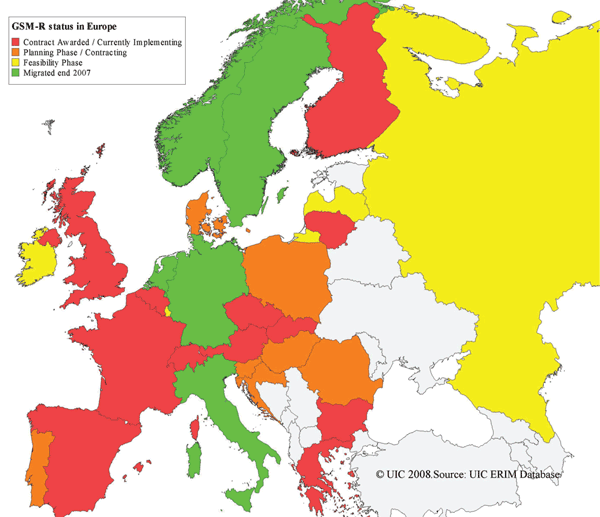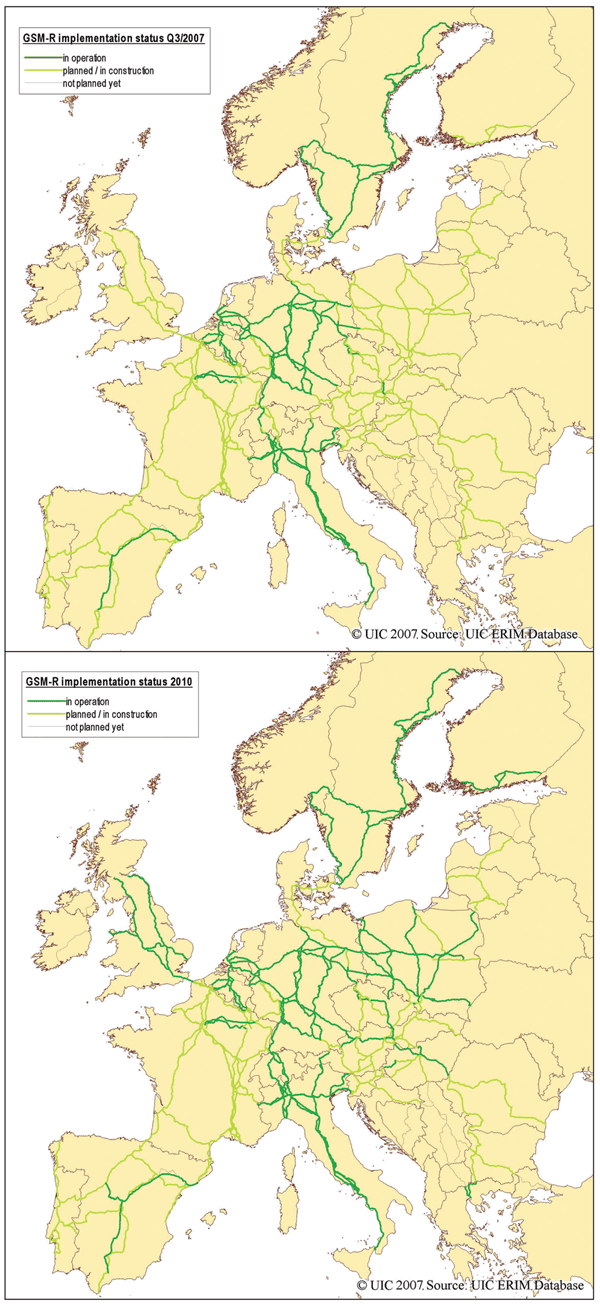GSM-R in 2008 – continuing the success story
Posted: 27 September 2008 | | No comments yet
Over the last few years, we have tried to give you an update about the GSM-R situation in and outside of Europe. In 2007, the implementations of GSM-R have already shown that GSM-R has become a success story, even if it could have been developed faster.
Over the last few years, we have tried to give you an update about the GSM-R situation in and outside of Europe. In 2007, the implementations of GSM-R have already shown that GSM-R has become a success story, even if it could have been developed faster.
Over the last few years, we have tried to give you an update about the GSM-R situation in and outside of Europe. In 2007, the implementations of GSM-R have already shown that GSM-R has become a success story, even if it could have been developed faster.
At the end of 2007, five railways had already finalised their implementation or they were at least in their main phase. In these five countries, GSM-R is already in full commercial operation, which means that the existing analogue radio will become obsolete and will be switched off step-by-step. In all the other countries which signed the “Agreement of Implementation” (AoI) in 1999, the implementation has at least started.
GSM-R is proven to be a working system, and has been taken into account all over Europe, as well as outside Europe. It was also proven to successfully work at 500km/h, during the tests performed in the exquisite trial when SNCF set a new speed record at 574.8km/h!
GSM-R is one of the important components of ERTMS and interoperable train operation across borders has already started. One of the pre-conditions for the cross border traffic is the interconnection of neighbouring GSM-R networks. Interconnections between several countries have been successfully set up.
Currently, the following interconnections are in place:
- Germany – Netherlands
- Germany – Switzerland
- Germany – Belgium
- Germany – France
- Sweden – Norway
- Italy – Switzerland
- France – Belgium
- Belgium – Netherlands
- Germany – Austria
- Germany – Czech Republic
Others are in preparation and will be active soon.
UIC has created two additional working groups to handle these important points. The result in the near future will be a new digital backbone network for railways.
Other administrations have started their implementations or are currently in the tendering phase. Austria has started with their pilot-line Passau – Wels and will rapidly continue to install GSM-R across their network. Greece, Bulgaria and Lithuania have started their GSM-R Implementation too. In the eastern part of Europe, preparation work is progressing and tenders are under way or are close to being sent out.
The map in Figure 1 shows the implementation plans and gives an overview on the implementation stage in Europe.
The upgraded statistics show that 147,813km are foreseen to be covered with GSM-R in Europe, from which 53,279km are already in operation, which means 36%!
As for the mobiles, 120,088 mobiles are activated, of which 25,889 are cab radios.
According to the national plans, in 2010, more then 60% of the foreseen network will be ready for operations.
In Figure 2 on page 107, you can see a 2007 / 2010 prediction for the European corridors coverage.
Nevertheless, there is still a lot of work to be done to keep this improvement running. One issue that is already visible is the lack of frequencies in some countries, which are in the heart of Europe and have GSM-R already in full swing. This is the case of congested areas, where even if not all the applications, foreseen to be used with GSM-R as a bearer, are implemented, the progressive usage of GSM-R needs most of the available resources.
Therefore one of the most urgent activities is to lobby for additional harmonised frequencies.
A work-item has been set up together with ETSI to apply for additional GSM-R frequencies, close to the existing ones. All railways are asked to support this activity, which should end with an additional amount of 3 to 5 MHz out of the so called Trunk Band. The good news is that the German frequency regulator BNetzA has already undertaken first steps to reserve 3 MHz (paired) for railways out of this band.
We are well aware that these additional frequencies would force the GSM-R suppliers to develop products suitable for this range, but for national applications in a first instance this activity would bring already advantages to those railways which are well advanced and use the existing frequencies extensively. This band would be well suited for another application which is due to lack of frequencies not yet in use, but under specification by ETSI. This is the so called Direct Mode (DMO), which could be used for some applications in congested areas, as well as in those areas which are not foreseen to be covered with GSM-R, especially in rural areas. It could also help to improve the implementation of digital shunting applications in congested areas as a national application, and for the use of the maintenance teams.
The other issue in relation with the lack of frequencies is the use of the GSM-R main application – the bearer for ETCS – which is not a resource optimised application. As ETCS is based on circuit switched data services, any train equipped with an active ETCS application in level two or higher, uses permanently along the whole trip one channel for the data transmission. This leads in areas with high traffic load to congestions in the GSM-R network. Therefore, several years ago a process was started to move this application towards a packet switched solution – the most suitable being GPRS.
UIC has performed studies in this area and produced a white-paper showing that GPRS would be a suitable solution for ETCS. There are still some concerns whether GPRS could fulfil the ETCS high performance requirements.
Most of the railways implementing GSM-R have also ordered GPRS to be implemented in their network. Some already have applications using GPRS services. Therefore some tests have been carried out in Italy and Sweden about the performance of GPRS and the relevant QoS values, with encouraging results. With some additional tests more focused on the needs of ETCS, it shall be proven in the next period that the existing GPRS can be suitable for ETCS without major adaptations of GPRS. A similar way as from ‘GSM to GSM-R towards GPRS and GPRS–R shall be avoided. The intention is clear to use standard GPRS.
After successful tests with GPRS, it is intended to modify the ETCS application to be able to use GPRS or another packet switched solution as the future data-service, but with a backward compatibility to the packet switched solution, in such a way that the two solutions will co-exist for a first period of time.
The GSM-R issues have migrated from a technical area to interoperability. As explained before, the GSM-R networks started to be interconnected, and trains with cab radios are travelling from one side of the continent to the other. The GSM-R cab radios are foreseen to work in different GSM-R networks, which have to respect the same EIRENE requirements.
To prove that the different products to be used in GSM-R are able to work in any GSM-R network, some testing and assessment is necessary. To ensure that these products comply to the GSM standard, tests can be carried out using the existing GSM test specifications and involving qualified test-houses. For GSM-R equipment, the relevant test-specification is just under preparation and qualified test-houses will come up soon. Nevertheless, these test-procedures and test-regulations have to be harmonised and commonly agreed.
The latest ERTMS MoU for the European corridors has taken this subject into consideration, and proposes the use of a European Test-Lab for GSM-R interoperability and other tests. This would allow a harmonised way of test and acceptance and would shorten the process of homologation. The European Railway Agency (ERA) has the task to define together with CER, EIM, GSM-R Industry Group and UIC the pre-conditions for such a test-lab. The work has already started. This test-lab can also be used for testing the new hardware and software releases before coming into force.
As a conclusion, GSM-R is on the right track. Work still remains to be done on specifications, technical improvement and at operational level, but tests have shown a robust system which is interoperable, that works well, that meets the requirements of ETCS and at the same time enable seamless communications for railways.


Figure 1: Implementation plans / stage in Europe


Figure 2: A 2007 / 2010 prediction for European corridor coverage
Stay Connected with Global Railway Review — Subscribe for Free!
Get exclusive access to the latest rail industry insights from Global Railway Review — all tailored to your interests.
✅ Expert-Led Webinars – Gain insights from global industry leaders
✅ Weekly News & Reports – Rail project updates, thought leadership, and exclusive interviews
✅ Partner Innovations – Discover cutting-edge rail technologies
✅ Print/Digital Magazine – Enjoy two in-depth issues per year, packed with expert content
Choose the updates that matter most to you. Sign up now to stay informed, inspired, and connected — all for free!
Thank you for being part of our community. Let’s keep shaping the future of rail together!






